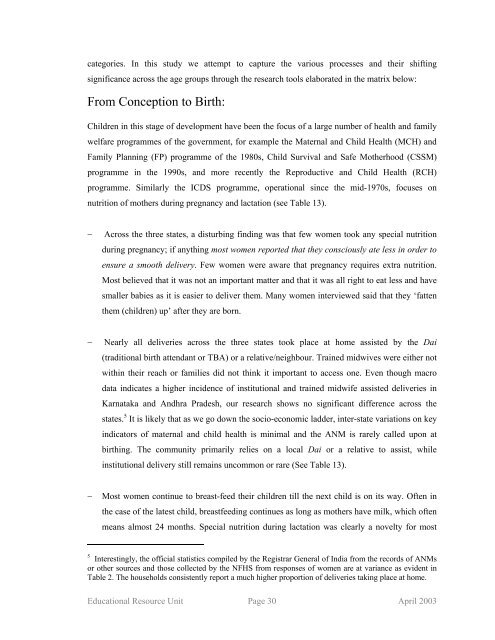Snakes and Ladders - ERU Consultants Pvt. Ltd.
Snakes and Ladders - ERU Consultants Pvt. Ltd.
Snakes and Ladders - ERU Consultants Pvt. Ltd.
You also want an ePaper? Increase the reach of your titles
YUMPU automatically turns print PDFs into web optimized ePapers that Google loves.
categories. In this study we attempt to capture the various processes <strong>and</strong> their shifting<br />
significance across the age groups through the research tools elaborated in the matrix below:<br />
From Conception to Birth:<br />
Children in this stage of development have been the focus of a large number of health <strong>and</strong> family<br />
welfare programmes of the government, for example the Maternal <strong>and</strong> Child Health (MCH) <strong>and</strong><br />
Family Planning (FP) programme of the 1980s, Child Survival <strong>and</strong> Safe Motherhood (CSSM)<br />
programme in the 1990s, <strong>and</strong> more recently the Reproductive <strong>and</strong> Child Health (RCH)<br />
programme. Similarly the ICDS programme, operational since the mid-1970s, focuses on<br />
nutrition of mothers during pregnancy <strong>and</strong> lactation (see Table 13).<br />
− Across the three states, a disturbing finding was that few women took any special nutrition<br />
during pregnancy; if anything most women reported that they consciously ate less in order to<br />
ensure a smooth delivery. Few women were aware that pregnancy requires extra nutrition.<br />
Most believed that it was not an important matter <strong>and</strong> that it was all right to eat less <strong>and</strong> have<br />
smaller babies as it is easier to deliver them. Many women interviewed said that they ‘fatten<br />
them (children) up’ after they are born.<br />
− Nearly all deliveries across the three states took place at home assisted by the Dai<br />
(traditional birth attendant or TBA) or a relative/neighbour. Trained midwives were either not<br />
within their reach or families did not think it important to access one. Even though macro<br />
data indicates a higher incidence of institutional <strong>and</strong> trained midwife assisted deliveries in<br />
Karnataka <strong>and</strong> Andhra Pradesh, our research shows no significant difference across the<br />
states. 5 It is likely that as we go down the socio-economic ladder, inter-state variations on key<br />
indicators of maternal <strong>and</strong> child health is minimal <strong>and</strong> the ANM is rarely called upon at<br />
birthing. The community primarily relies on a local Dai or a relative to assist, while<br />
institutional delivery still remains uncommon or rare (See Table 13).<br />
− Most women continue to breast-feed their children till the next child is on its way. Often in<br />
the case of the latest child, breastfeeding continues as long as mothers have milk, which often<br />
means almost 24 months. Special nutrition during lactation was clearly a novelty for most<br />
5 Interestingly, the official statistics compiled by the Registrar General of India from the records of ANMs<br />
or other sources <strong>and</strong> those collected by the NFHS from responses of women are at variance as evident in<br />
Table 2. The households consistently report a much higher proportion of deliveries taking place at home.<br />
Educational Resource Unit Page 30 April 2003












